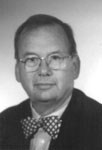
> COCI Visit to China
> News and Notices
> Reports from
Symposia
> New Projects
> Provisional Recommendations
> New Books
> Conference
Announcements
> Conference Calendar
Download the September
issue in pdf format.
(393KB)
Download the September
cover in pdf format.
(71KB)
Chemistry International
Vol. 23, No.5
September 2001
Report of Treasurer and
Report of Finance CommitteeDr. Christoph Buxtorf, IUPAC Treasurer and recently retired Head of Production and Technology of Novartis Crop Protection (Switzerland), and Dr. Edwin Przybylowicz, Chairman of the IUPAC Finance Committee and retired Director of Research at Eastman Kodak Co. (USA), have submitted these reports on the financial condition of IUPAC.
General Remarks
I would like to present IUPAC financial status by providing an audited statement of income and spending to our members. We last presented a detailed financial statement in the July 2000 issue of Chemistry International (CI). The Bureau and Council voted to support budgets for the next biennium at our General Assembly in Brisbane in July 2001. This annual report is a good place to give answers to some of the questions about IUPAC finances.
From Where Does IUPAC Get its Money?
IUPAC has the following main sources of income: Membership Dues from National Adhering Organizations (NAOs): The NAOs support IUPAC 's role as a leading international body in the field of chemistry through active programs and project work in the fields of nomenclature, research, teaching, and systems providing unimpeded access to information. The national subscriptions are based on the national chemical turnover through an established formula. The calculations of the chemical turnover and the payments are made in U.S. dollars (USD). Voting representation of each member country is broadly related to the national subscription, thus ensuring the voice of each NAO in the international world of chemistry. Solidarity and commitment are the warranty for the sustainable work of IUPAC.
Unfortunately, we see some serious signs of discontinuity in the future.
Publications: Our publication Pure and Applied Chemistry (PAC) has become–at least for the time being–a very important source of income. This situation was, in particular, made possible by a switch from external publishing to IUPAC becoming its own publisher. We have kept the subscription fees constant over the last two years. Owing to higher printing and shipping costs, we should increase the price moderately.
Interest from our Investments: In the past few years, the excellent performance of the financial markets has allowed IUPAC to grow the long-term account to finance various endeavors (see details in comments of the Chairman of the Finance Committee below). However, during the past two years, the investment markets were difficult and, therefore, the available income was smaller than in earlier years.
Grants: Periodically, ICSU and IUPAC collaborate on projects. Such project-related funds are not part of our regular income.
Donations: Unfortunately, this part is actually very small. However, there are some opportunities for project funding in the areas of research and education. We definitely need more effort in these areas to receive funds from industry and other agencies.
How Does IUPAC Spend its Money?
IUPAC is a nonprofit organization, and any revenue is used to support chemistry activities around the world. The IUPAC Strategic Plan has facilitated focused activities.
The main expenses of IUPAC are as follows: International Meetings: IUPAC supports a number of international meetings–including the World Congresses–with loans, grants, and travel subsidies, in line with programs and project work. Scientific Advisory Activities: The Divisions and Committees of IUPAC have the responsibility to produce scientific evidence to support nomenclature (e.g., together with Chemical Abstracts, the Beilstein Society, and patent agencies), standardization, research, teaching, and information systems (e.g., Web sites) to sustain chemical science in the service of mankind.
Publications: IUPAC publishes CI as an information tool to stay in contact with its Members and Affiliate Members and PAC, a journal for the international scientific community, with reports and recommendations emanating from IUPAC 's project work and manuscripts from IUPAC-sponsored conferences and symposia. The maintenance and expansion of the IUPAC Web site is a new and important activity in this context. Through careful management, the overall expenses for these publications have been substantially reduced.
Reduction of Administrative Costs
Administrative costs have been well managed in the last biennium. The move from Oxford to Research Triangle Park has been quite successful in terms of cost and benefit. The addition of staff is carefully evaluated and only accepted if a clear benefit for IUPAC can be demonstrated. Many services are performed under contract, which helps keep costs down.
Future Initiatives
IUPAC is on the way to focusing more on project-driven activities. It may present a big challenge to make this move rapidly without losing competence. Furthermore, a revision of the Strategic Plan will support better focus and a more efficient allocation of resources.
Income and Expenses
A major and successful financial turnaround is the best description of what happened during the period 1991-1999 under Prof. John Ward as Treasurer. The financial health of IUPAC is, therefore, good. The future, however, has some downside risks, which may be anticipated as a review of the financial summary of the last three years clearly shows.
This summary indicates that our total financial support in 2000 was down some 8% over the previous year, owing in part to a decrease in grants and contributions from outside sources and a decline in National Subscriptions (owing to some countries with financial problems and membership cancellations). Additionally, the investment environment was difficult in 2000, and the impact is quite apparent in our investment income. In the area of publications, the impact of the move from outside to inside publishing in 2000 is very positive. Even with the higher administrative costs associated with this change, the net income from publications is greater under the new system than it was with an outside publisher. The bottom line shows a steady, but declining, increase in net assets.
A special report on IUPAC 's long-term investments and reserve funds is given below by Dr. Ed Przybylowicz (Finance Committee Report).
Summary and Conclusions
An analysis of the above table indicates that the financial health of IUPAC is good, the reserves are still growing, but our income side has some areas of concern. On the expense side, the move from commission driven costs to a more project-driven system remains to be experienced. As a starting point, we are planning that the balance between operations and projects will be 25%/75%. It remains to be seen whether experience will bear this out. It is possible that we may not fully use the project funds allocated to the Divisions and the Division Reserve in the next period. For this reason, we propose that there be only a 1% increase per annum in the National Subscriptions for the next biennium. To help offset increases in publication costs, we are recommending that the Committee on Printed and Electronic Publications consider a 5% per annum increase in the subscription prices of PAC. Beyond this biennium, we may have to be prepared to increase the National Subscriptions in the period 2003-2005 at a higher rate, depending on our experience with the new project system.
IUPAC Accounts, 1998-2000
Support Grants and contributions, USD National Subscriptions Affiliate Membership Program Total support Other revenues Publications Investment income Other Total other revenues Total support and other revenues Expenses Program Management and general Total expenses Increase in net assets Net assets, beginning of year Net assets, end of year *Reflects large increases in both income and expenses from self-publishing.
It is most important that we spend IUPAC funds on strategically important projects, making visible to our outside world of customers those accomplishments that IUPAC is in a unique position to provide. This effort will require focusing on fewer, high-priority tasks. For the next biennium, the allocation to the Divisions will follow mainly the pattern of past expenditures, as proposed to the Bureau at its meeting in September 2000. As we take on new tasks, such as the Systematic Nomenclature and Structure Representation Division, more activity in COCI, and educational efforts, the allocations will be different. The next biennium is, in many respects, a provisional one, with some uncertainties that will be resolved through the experience of the next two years. For future biennia, it will be up to the Executive Committee and the Bureau to develop focused strategies that give clear guidelines to the Finance Committee and to the Treasurer to allocate the funds in the most sensible way.
Acknowledgments
The present work of the Treasurer was only possible thanks to the great cooperation and help of the Executive Director, the Finance Committee, and last– but not least–the outstanding heritage of my predecessor, Prof. John Ward.
According to the standing orders of the Finance Committee (FC), the FC is charged broadly with providing financial advice to IUPAC, as well as the responsibility for IUPAC securities in the long-term accounts. Over the past biennium, our long-term investments have been handled through the Merrill Lynch International Bank Limited with offices in New York City. The holdings in the IUPAC long-term investment account are a mixture of international equity funds and international bonds, with approximately 1-2% of the funds being available in a money market fund for liquidity.
The investment market over the past two years was very mixed. The year 1999 showed poor performance early in the year; however, the fourth quarter ended strong. In 2000, the markets took a decided turn downward from the preceding several years when growth was high. It was the end of a prolonged period of outstanding investment opportunities.
The downward turn in the markets, especially during the past year, had its way with the IUPAC portfolio. For the biennium, 1999-2000, the value of our long-term portfolio increased from USD 3 465 219 to USD 4 359 888, or 25.8%. However, a significant portion of this increase is due to under-running the operating budgets during this biennium and transfer of those funds to the long-term account. During 1999, the investments yielded an 11.9% increase, largely due to a market rally in the fourth quarter of the year. During the year 2000, however, our investments decreased in value by 1% in an equity investment market that decreased by over 9%. Financially, we have done well in a rather poor investment market. In view of the recent volatility of the equity markets and the goal of the FC to "preserve capital", a decision was taken at the FC meeting in March 2001 to move to a 50/50 ratio of equity-to-fixed income in the long-term portfolio.
The Finance Committee and Executive Committee also approved an IUPAC Investment Policy and a Fund Policy Statement that provide an annual operating description of how the long-term investment account is allocated to various funds of the organization. These policy statements are available upon request to the Secretariat.
In summary, the long-term investment account of IUPAC is in good shape and can provide financial stability for the annual operations of the Union, as well as income to support certain special projects. As the Treasurer points out in his report, the health of this account depends on a continued strong investment market.
As FC chairman, my thanks go to our Treasurer and to the FC committee members for their advice and counsel, as well as to the officers of IUPAC for their continued support. Special thanks go to Dr. Alfred Hartmann, a retired member of the FC, and to Prof. John Ward, past-Treasurer, who have attended the FC meetings during the past two years and participated in our deliberations.
> Link to Finance Committee
News
and Notices - Organizations and People
- Standing Committees
Divisions
- Projects - Reports
- Publications - Symposia
- AMP - Links
Page last modified 17 August 2001.
Copyright © 1997-2001 International Union of Pure and Applied Chemistry.
Questions or comments about IUPAC, please
contact the Secretariat.
Questions regarding the website, please contact [email protected]


